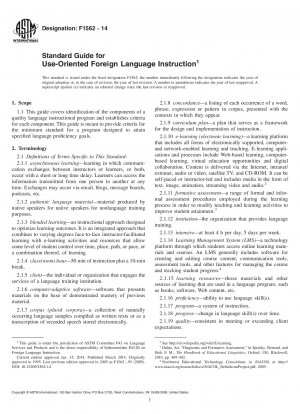ASTM F1562-14
Standard Guide for Use-Oriented Foreign Language Instruction
- Standard No.
- ASTM F1562-14
- Release Date
- 2014
- Published By
- American Society for Testing and Materials (ASTM)
- Status
- Replace By
- ASTM F1562-23
- Latest
- ASTM F1562-23
- Scope
3.1 This guide is intended to serve institutions for the development of instructional programs as well as to serve potential clients and students in the selection of a training program to meet their needs.
3.2 It may not be possible for a specific program to meet all of the components of the standard for every language. If the standard cannot be met for a given language, the institution will clearly inform the client and the student of that fact.
3.3 The following components are addressed:
3.3.1 Needs Analysis—Assists clients and training institutions in determining language needs, setting reasonable objectives and expectations, and selecting appropriate training programs.
3.3.2 Describing Levels of Language Proficiency—Assists students, clients, instructors, and institutions in assessing needs, setting realistic goals, and charting progress toward those goals.
3.3.3 Explicitness and Reasonableness of Language Outcome Expectations—Assists in determining an individual's need for training to increase proficiency. Determines the estimated number of classroom hours required to meet an identified proficiency objective. Assists in determining the suitability of an institution to provide appropriate instruction.
3.3.3.1 These guidelines are not intended to be absolute. Individual cases may be influenced by a number of factors, including: individual language learning ability, prior language experience, native language, attendance, motivation, homework, exposure and reinforcement outside the classroom, and individual learning style.
3.3.4 Training Program Criteria—Assists students, clients, and institutions in identifying and establishing a use-oriented training program.
3.3.5 Establishing Criteria for Language Instructors—Assists in recruiting, selecting, and retaining instructors.
3.3.6 Supervision of Instructors—Emphasizes the importance of the supervisory role that may be performed by one or more individuals. Assists institutions in establishing supervisory procedures and gives guidelines to clients for evaluating a training program to meet their needs.
3.3.7 Evaluating Student Progress in Language Proficiency Terms—Establishes minimum requirements for evaluating and documenting student progress in terms of language proficiency for the benefit of clients, students, institutions, and instructors.
3.3.8 Guides for Institutional Stability—Provides clients with criteria by which to determine the stability of an institution.
3.3.9 Advertising and Promotional Activities—Assists institutions in preparing advertising and promotional materials and assists clients in interpreting and understanding such advertising and materials.
3.3.9.1 These guidelines shall apply to advertising, such as print, broadcasting, and electronic media, as well as oral presentations.
1.1 This guide covers identification of the components of a quality language instructional program and establishes criteria for each component. This guide is ......
ASTM F1562-14 history
- 2023 ASTM F1562-23 Standard Guide for Use-Oriented Foreign Language Instruction
- 2014 ASTM F1562-14 Standard Guide for Use-Oriented Foreign Language Instruction
- 1995 ASTM F1562-95(2005) Standard Guide for Use-Oriented Foreign Language Instruction
- 1995 ASTM F1562-95(1999) Standard Guide for Use-Oriented Foreign Language Instruction

Copyright ©2024 All Rights Reserved